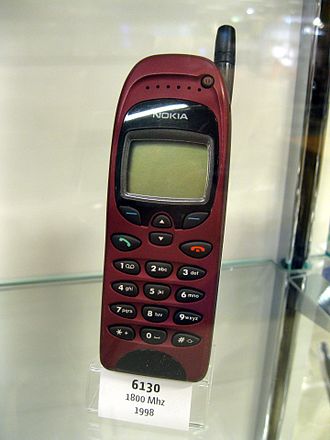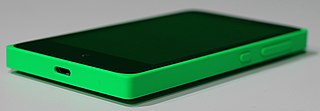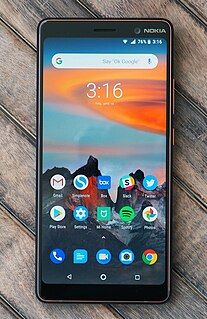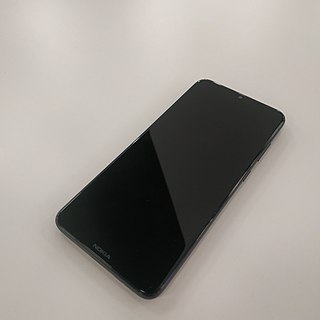
The Nokia 6130 is a mobile phone released in 1998 by Nokia. [1]

The Nokia 6130 is a mobile phone released in 1998 by Nokia. [1]

Nokia Corporation is a Finnish multinational telecommunications, information technology, and consumer electronics company, founded in 1865. Nokia's main headquarters are in Espoo, Finland, in the greater Helsinki metropolitan area, but the company's actual roots are in the Tampere region of Pirkanmaa. In 2020, Nokia employed approximately 92,000 people across over 100 countries, did business in more than 130 countries, and reported annual revenues of around €23 billion. Nokia is a public limited company listed on the Helsinki Stock Exchange and New York Stock Exchange. It is the world's 415th-largest company measured by 2016 revenues according to the Fortune Global 500, having peaked at 85th place in 2009. It is a component of the Euro Stoxx 50 stock market index.

The Nokia 6110 was a GSM mobile phone from Nokia announced on 18 December 1997 and released in 1998. It is not to be confused with the newer Nokia 6110 Navigator. It was a hugely popular follower of the Nokia 2110, and the first of the many Nokia 6xxx series business-targeted phones. Main improvements over the 2110 were reduced size and improved talk time. It was the first GSM phone to use an ARM processor, as well as the first running on Nokia's Series 20 user interface.
Series 40, often shortened as S40, is a software platform and application user interface (UI) software on Nokia's broad range of mid-tier feature phones, as well as on some of the Vertu line of luxury phones. It was one of the world's most widely used mobile phone platforms and found in hundreds of millions of devices. Nokia announced on 25 January 2012 that the company has sold over 1.5 billion Series 40 devices. It was not used for smartphones, with Nokia turning first to Symbian, then in 2012–2017 to Windows Phone, and most recently Android. However, in 2012 and 2013, several Series 40 phones from the Asha line, such as the 308, 309 and 311, were advertised as "smartphones" although they do not actually support smartphone features like multitasking or a fully fledged HTML browser.
Nokia's strategic nomenclature can be traced back in 2005 when the Nseries line was launched, offering devices with flagship specifications and premium hardware at various price points. These devices were considered the "bread and butter" of the company and were often positioned to showcase their latest technologies. Thanks to the newfound consumer and enterprise interest in smartphones at the time, the company introduced four additional collections to diversify their product portfolio and meet demands in most market segments. These new phone series were named Eseries, targeting small business and enterprise customers; Xseries, providing consumer-grade multimedia-focused devices; Cseries, which Nokia used to target both the low-end and mid-range market segments; and Tseries, for devices exclusive to the Chinese market.

Microsoft Lumia is a discontinued line of mobile devices that was originally designed and marketed by Nokia and later by Microsoft Mobile. Introduced in November 2011, the line was the result of a long-term partnership between Nokia and Microsoft—as such, Lumia smartphones run on Microsoft software, the Windows Phone operating system; and later the newer Windows 10 Mobile. The Lumia name is derived from the partitive plural form of the Finnish word lumi, meaning "snow".

The Nokia X was a mid-tier smartphone announced as part of the Nokia X family in February 2014, running on the Nokia X platform. The device shipped on the same day as the unveiling, with Nokia targeting the product for emerging markets, and was sold and maintained by Microsoft Mobile. On 17 July 2014, Microsoft announced that it would discontinue the line.

The Nokia X family was a range of budget smartphones that was produced and marketed by Microsoft Mobile, originally introduced in February 2014 by Nokia. The smartphones run on the Nokia X platform, a Linux-based operating system which was a fork of Android. Nokia X is also known generally as the Nokia Normandy. It is regarded as Nokia's first Android device during the company's Microsoft partnership and was in the process of selling its mobile phone business to Microsoft, which eventually happened two months later.

Microsoft Mobile was a subsidiary of Microsoft involved in the development and manufacturing of mobile phones. Based in Espoo, Finland, it was established in 2014 following the acquisition of Nokia's Devices and Services division by Microsoft in a deal valued at €5.4 billion, which was completed in April 2014. Nokia's then-CEO, Stephen Elop, joined Microsoft as president of its Devices division following the acquisition, and the acquisition was part of Steve Ballmer's strategy to turn Microsoft into a "devices and services" company. Under a 10-year licensing agreement, Microsoft Mobile held rights to sell feature phones running the S30+ platform under the Nokia brand.

HMD Global Oy, branded as HMD and Nokia Mobile, is a Finnish mobile phone manufacturer. The company is made up of the mobile phone business that Nokia sold to Microsoft in 2014, then bought back in 2016. HMD began marketing Nokia-branded smartphones and feature phones on 1 December 2016. The company has exclusive rights to the Nokia brand for mobile phones through a licensing agreement. The HMD brand is only used for corporate purposes and does not appear in advertising, whereas the name "Nokia Mobile" is used on social media.
The Nokia 7 is a mid-range Nokia-branded smartphone running Android, by HMD Global. It was launched on 19 October 2017 and was released on 24 October exclusively in China.
The Nokia 8 Sirocco (TA-1005) is a high-end smartphone running the Android One variant of Android. It was introduced at MWC in February 2018, and named after the Nokia 8800 Sirocco. The successor of the Nokia 8 Sirocco is the Nokia 9 PureView.

The Nokia 7 Plus is a Nokia-branded upper-mid-range smartphone running the Android operating system. It was announced on 25 February 2018, along with four other Nokia-branded phones.
The Nokia 3.1 is a Nokia-branded entry-level Android smartphone released in May 2018 by HMD Global. It is the successor to Nokia 3. It was launched with Android 8.0 "Oreo", which could be updated to Android 10. The phone is part of Google's Android One program.
The Nokia 2.2 is a Nokia-branded entry-level Android smartphone released in June 2019. It is the successor to Nokia 2.1.
The Nokia 7.2 is a Nokia branded Android smartphone announced on 6 September at IFA 2019 launching at $349/£249 for the cheapest model.
The Nokia 2.3 is a Nokia-branded low-end smartphone launched in December 2019 running the Android operating system
The Nokia 1.3 is a Nokia-branded smartphone by HMD Global, running Android Go. It was announced on March 19, 2020 alongside the Nokia 8.3 5G, Nokia 5.3 and Nokia 5310 (2020).

The Nokia 5.3 is a Nokia-branded mid-range smartphone by HMD Global, running Android One. It was announced on March 19, 2020, alongside the Nokia 8.3 5G, Nokia 1.3 and Nokia 5310 (2020).
The Nokia C2 is a Nokia-branded entry-level smartphone by HMD Global, running Android Go. It was announced on March 16, 2020.